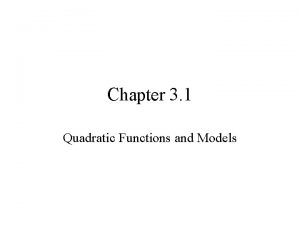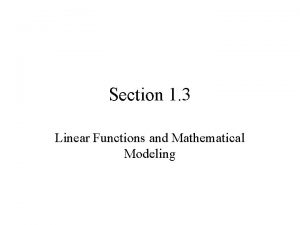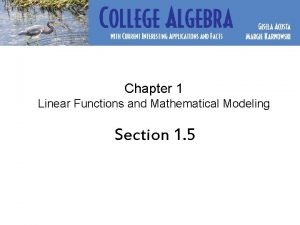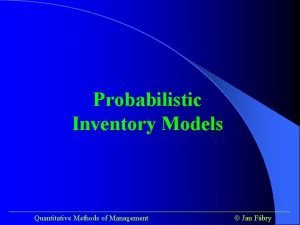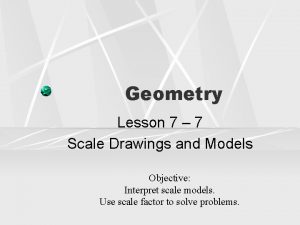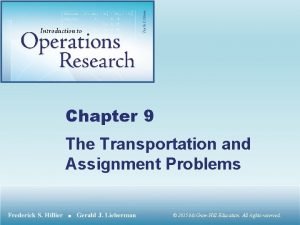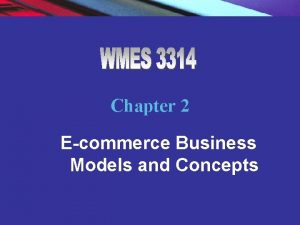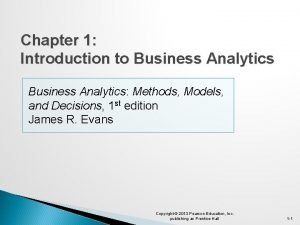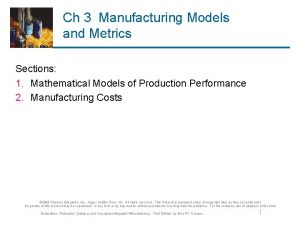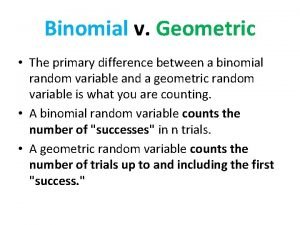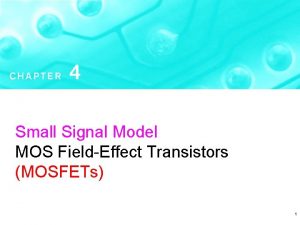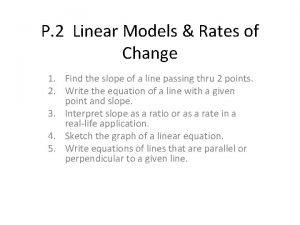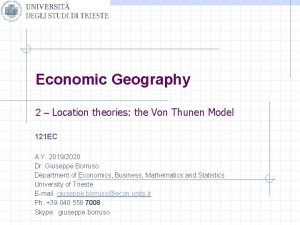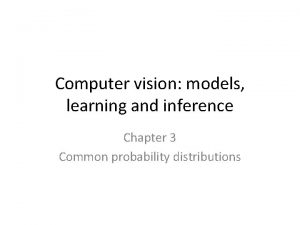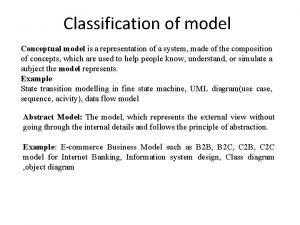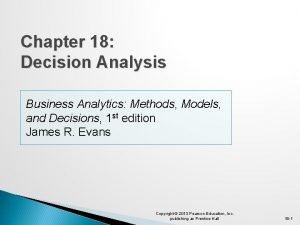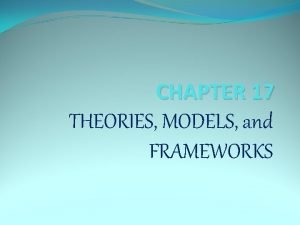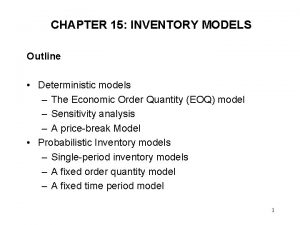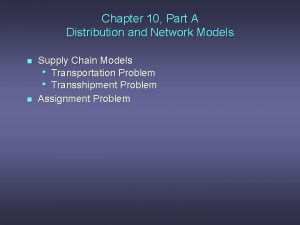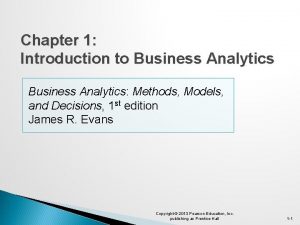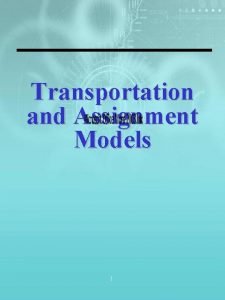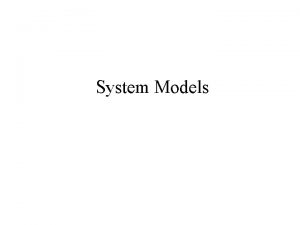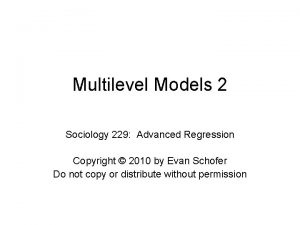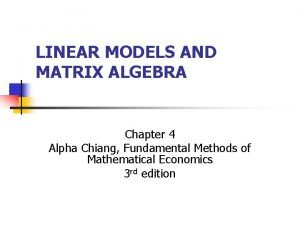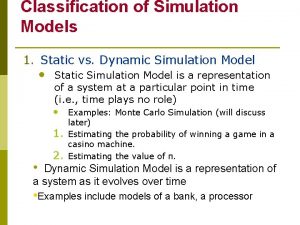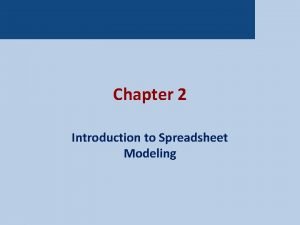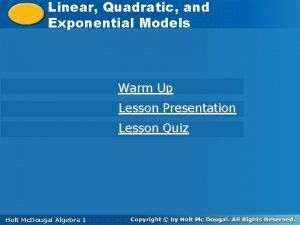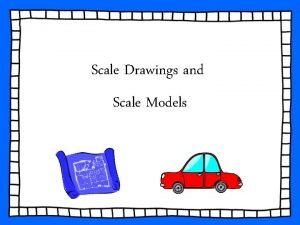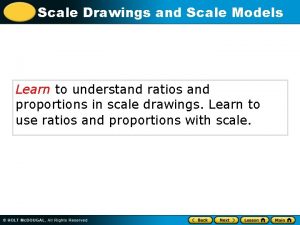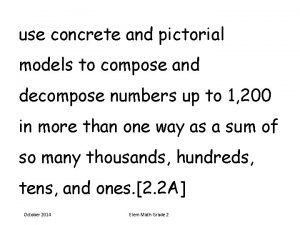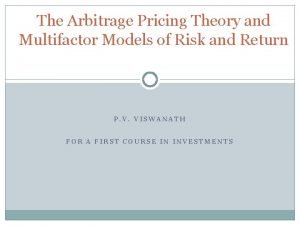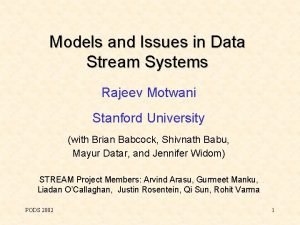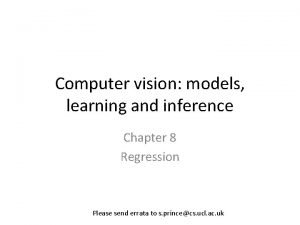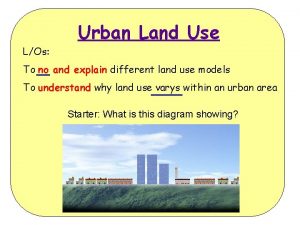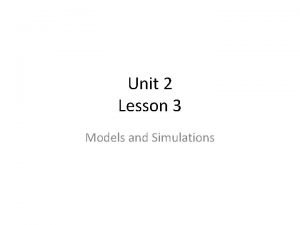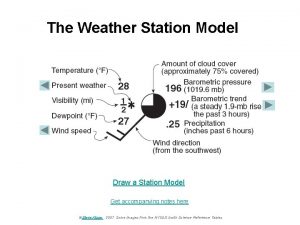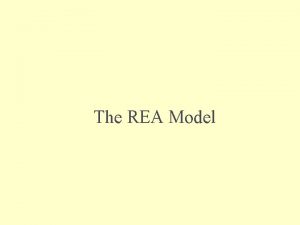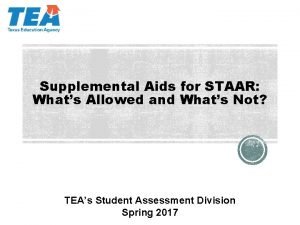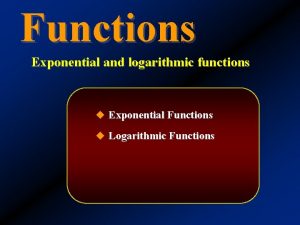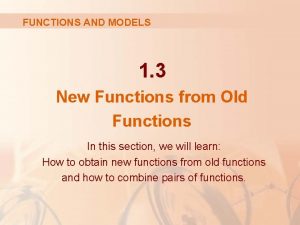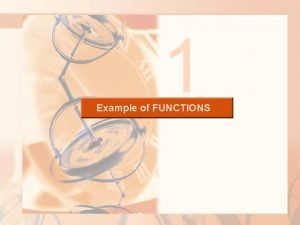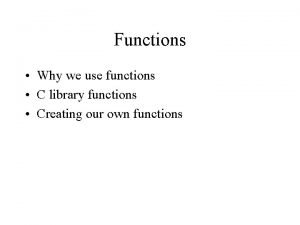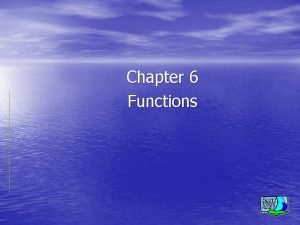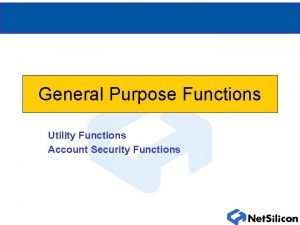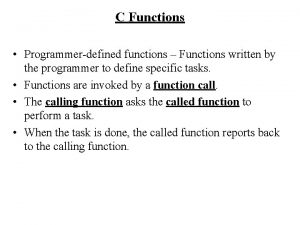1 FUNCTIONS AND MODELS FUNCTIONS AND MODELS 1

























































































![INVERSE SINE FUNCTIONS The inverse sine function, sin-1, has domain [-1, 1] and range INVERSE SINE FUNCTIONS The inverse sine function, sin-1, has domain [-1, 1] and range](https://slidetodoc.com/presentation_image/d113e0f14fd761f103458f50fd0e1a7e/image-90.jpg)



![INVERSE COSINE FUNCTIONS The inverse cosine function, cos-1, has domain [-1, 1] and range. INVERSE COSINE FUNCTIONS The inverse cosine function, cos-1, has domain [-1, 1] and range.](https://slidetodoc.com/presentation_image/d113e0f14fd761f103458f50fd0e1a7e/image-94.jpg)










- Slides: 104

1 FUNCTIONS AND MODELS

FUNCTIONS AND MODELS 1. 6 Inverse Functions and Logarithms In this section, we will learn about: Inverse functions and logarithms.

INVERSE FUNCTIONS The table gives data from an experiment in which a bacteria culture started with 100 bacteria in a limited nutrient medium. § The size of the bacteria population was recorded at hourly intervals. § The number of bacteria N is a function of the time t: N = f(t).

INVERSE FUNCTIONS However, suppose that the biologist changes her point of view and becomes interested in the time required for the population to reach various levels. § In other words, she is thinking of t as a function of N.

INVERSE FUNCTIONS This function is called the inverse function of f. § It is denoted by f -1 and read “f inverse. ”

INVERSE FUNCTIONS Thus, t = f -1(N) is the time required for the population level to reach N.

INVERSE FUNCTIONS The values of f -1 can be found by reading the first table from right to left or by consulting the second table. § For instance, f -1(550) = 6, because f(6) = 550.

INVERSE FUNCTIONS Not all functions possess inverses. § Let’s compare the functions f and g whose arrow diagrams are shown.

INVERSE FUNCTIONS Note that f never takes on the same value twice. § Any two inputs in A have different outputs.

INVERSE FUNCTIONS However, g does take on the same value twice. § Both 2 and 3 have the same output, 4.

INVERSE FUNCTIONS In symbols, g(2) = g(3) but f(x 1) ≠ f(x 2) whenever x 1 ≠ x 2

INVERSE FUNCTIONS Functions that share this property with f are called one-to-one functions.

ONE-TO-ONE FUNCTIONS Definition 1 A function f is called a one-to-one function if it never takes on the same value twice. That is, f(x 1) ≠ f(x 2) whenever x 1 ≠ x 2

ONE-TO-ONE FUNCTIONS If a horizontal line intersects the graph of f in more than one point, then we see from the figure that there are numbers x 1 and x 2 such that f(x 1) = f(x 2). § This means f is not one-to-one.

ONE-TO-ONE FUNCTIONS So, we have the following geometric method for determining whether a function is one-to-one.

HORIZONTAL LINE TEST A function is one-to-one if and only if no horizontal line intersects its graph more than once.

ONE-TO-ONE FUNCTIONS Is the function 3 f(x) = x one-to-one? Example 1

ONE-TO-ONE FUNCTIONS E. g. 1—Solution 1 If x 1 ≠ x 2, then x 1 ≠ x 2 3 3. § Two different numbers can’t have the same cube. § So, by Definition 1, f(x) = x 3 is one-to-one.

ONE-TO-ONE FUNCTIONS E. g. 1—Solution 2 From the figure, we see that no horizontal line intersects the graph of f(x) = x 3 more than once. § So, by the Horizontal Line Test, f is one-to-one.

ONE-TO-ONE FUNCTIONS Is the function 2 g(x) = x one-to-one? Example 2

ONE-TO-ONE FUNCTIONS E. g. 2—Solution 1 The function is not one-to-one. § This is because, for instance, g(1) = 1 = g(-1) and so 1 and -1 have the same output.

ONE-TO-ONE FUNCTIONS E. g. 2—Solution 2 From the figure, we see that there are horizontal lines that intersect the graph of g more than once. § So, by the Horizontal Line Test, g is not one-to-one.

ONE-TO-ONE FUNCTIONS One-to-one functions are important because they are precisely the functions that possess inverse functions according to the following definition.

ONE-TO-ONE FUNCTIONS Definition 2 Let f be a one-to-one function with domain A and range B. Then, its inverse function f -1 has domain B and range A and is defined by for any y in B.

ONE-TO-ONE FUNCTIONS The definition states that, if f maps x into y, then f -1 maps y back into x. § If f were not one-to-one, then f -1 would not be uniquely defined.

ONE-TO-ONE FUNCTIONS The arrow diagram in the figure indicates that f -1 reverses the effect of f.

ONE-TO-ONE FUNCTIONS Note that: domain of f -1 = range of f -1 = domain of f

ONE-TO-ONE FUNCTIONS For example, the inverse function of f(x) = x 3 is f -1(x) = x 1/3. § This is because, if y = x 3, then f -1(y) = f -1(x 3) = (x 3)1/3 = x

ONE-TO-ONE FUNCTIONS Caution Do not mistake the -1 in f -1 for an exponent. § Thus, f -1(x) does not mean § However, the reciprocal as [f(x)]-1. . could be written

ONE-TO-ONE FUNCTIONS Example 3 If f(1) = 5, f(3) = 7, and f(8) = -10, find f -1(7), f -1(5), and f -1(-10). § From the definition of f -1, we have: f -1(7) = 3 f -1(5) = 1 f -1(-10) = 8 because f(3) = 7 f(1) = 5 f(8) = -10

ONE-TO-ONE FUNCTIONS Example 3 This diagram makes it clear how f -1 reverses the effect of f in this case.

ONE-TO-ONE FUNCTIONS Definition 3 The letter x is traditionally used as the independent variable. So, when we concentrate on f -1 rather than on f, we usually reverse the roles of x and y in Definition 2 and write:

CANCELLATION EQUATIONS Definition 4 By substituting for y in Definition 2 and substituting for x in Definition 3, we get the following cancellation equations: f -1(f(x)) = x for every x in A f(f -1(x)) = x for every x in B

CANCELLATION EQUATION 1 The first cancellation equation states that, if we start with x, apply f, and then apply f -1, we arrive back at x, where we started. Thus, f -1 undoes what f does.

CANCELLATION EQUATION 2 The second equation states that f undoes what f -1 does.

CANCELLATION EQUATIONS For example, if f(x) = x 3, then f -1(x) = x 1/3. So, the cancellation equations become: f -1(f(x)) = (x 3)1/3 = x f(f -1(x)) = (x 1/3)3 = x § These equations simply states that the cube function and the cube root function cancel each other when applied in succession.

INVERSE FUNCTIONS Now, let’s see how to compute inverse functions. § If we have a function y = f(x) and are able to solve this equation for x in terms of y, then, according to Definition 2, we must have x = f -1(y). § If we want to call the independent variable x, we then interchange x and y and arrive at the equation y = f -1(x).

INVERSE FUNCTIONS Definition 5 Now, let’s see how to find the inverse function of a one-to-one function f. 1. Write y = f(x). 2. Solve this equation for x in terms of y (if possible). 3. To express f -1 as a function of x, interchange x and y. The resulting equation is y = f -1(x).

INVERSE FUNCTIONS Example 4 Find the inverse function of f(x) = x 3 + 2. § By Definition 5, we first write: y = x 3 + 2. § Then, we solve this equation for x : § Finally, we interchange x and y : § So, the inverse function is:

INVERSE FUNCTIONS The principle of interchanging x and y to find the inverse function also gives us the method for obtaining the graph of f -1 from the graph of f. § As f(a) = b if and only if f -1(b) = a, the point (a, b) is on the graph of f if and only if the point (b, a) is on the graph of f -1.

INVERSE FUNCTIONS However, we get the point (b, a) from (a, b) by reflecting about the line y = x.

INVERSE FUNCTIONS Thus, the graph of f -1 is obtained by reflecting the graph of f about the line y = x.

INVERSE FUNCTIONS Example 5 Sketch the graphs of and its inverse function using the same coordinate axes.

INVERSE FUNCTIONS Example 5 First, we sketch the curve (the top half of the parabola y 2 = -1 -x, or x = -y 2 - 1). Then, we reflect about the line y = x to get the graph of f -1.

INVERSE FUNCTIONS Example 5 As a check on our graph, notice that the expression for f -1 is f -1(x) = - x 2 - 1, x ≥ 0. § So, the graph of f -1 is the right half of the parabola y = - x 2 - 1. § This seems reasonable from the figure.

LOGARITHMIC FUNCTIONS If a > 0 and a ≠ 1, the exponential function f(x) = ax is either increasing or decreasing, so it is one-to-one by the Horizontal Line Test. Thus, it has an inverse function f -1, which is called the logarithmic function with base a and is denoted by loga.

LOGARITHMIC FUNCTIONS Definition 6 If we use the formulation of an inverse function given by Definition 3, then we have:

LOGARITHMIC FUNCTIONS Thus, if x > 0, then logax is the exponent to which the base a must be raised to give x. § For example, log 100. 001 = - 3 because 10 -3 = 0. 001

LOGARITHMIC FUNCTIONS Definition 7 The cancellation equations, when applied to the functions f(x) = ax and f -1(x) = logax, become: for every

LOGARITHMIC FUNCTIONS The logarithmic function loga has domain and. § Its graph is the reflection of the graph of y = ax about the line y = x.

LOGARITHMIC FUNCTIONS The figure shows the case where a > 1. § The most important logarithmic functions have base a > 1.

LOGARITHMIC FUNCTIONS The fact that y = ax is a very rapidly increasing function for x > 0 is reflected in the fact that y = logax is a very slowly increasing function for x > 1.

LOGARITHMIC FUNCTIONS The figure shows the graphs of y = logax with various values of the base a > 1. § Since loga 1 = 0, the graphs of all logarithmic functions pass through the point (1, 0).

LOGARITHMIC FUNCTIONS The following properties of logarithmic functions follow from the corresponding properties of exponential functions given in Section 1. 5.

LAWS OF LOGARITHMS If x and y are positive numbers, then 1. 2. 3.

LAWS OF LOGARITHMS Example 6 Use the laws of logarithms to evaluate log 280 - log 25. § Using Law 2, we have because 24 = 16.

NATURAL LOGARITHMS Of all possible bases a for logarithms, we will see in Chapter 3 that the most convenient choice of a base is the number e, which was defined in Section 1. 5

NATURAL LOGARITHM The logarithm with base e is called the natural logarithm and has a special notation:

NATURAL LOGARITHMS Definitions 8 and 9 If we put a = e and replace loge with ‘ln’ in Definitions 6 and 7, then the defining properties of the natural logarithm function become:

NATURAL LOGARITHMS In particular, if we set x = 1, we get:

NATURAL LOGARITHMS E. g. 7—Solution 1 Find x if ln x = 5. § From Definition 8, we see that ln x = 5 means e 5 = x. § Therefore, x = e 5.

NATURAL LOGARITHMS E. g. 7—Solution 1 If you have trouble working with the ‘ln’ notation, just replace it by loge. § Then, the equation becomes loge x = 5. § So, by the definition of logarithm, e 5 = x.

NATURAL LOGARITHMS E. g. 7—Solution 2 Start with the equation ln x = 5. Then, apply the exponential function to both sides of the equation: eln x = e 5 § However, the second cancellation equation in Definition 9 states that eln x = x. § Therefore, x = e 5.

NATURAL LOGARITHMS Example 8 Solve the equation e 5 - 3 x = 10. § We take natural logarithms of both sides of the equation and use Definition 9: § As the natural logarithm is found on scientific calculators, we can approximate the solution— to four decimal places: x ≈ 0. 8991

NATURAL LOGARITHMS Express logarithm. Example 9 as a single § Using Laws 3 and 1 of logarithms, we have:

NATURAL LOGARITHMS The following formula shows that logarithms with any base can be expressed in terms of the natural logarithm.

CHANGE OF BASE FORMULA Formula 10 For any positive number a (a ≠ 1), we have:

CHANGE OF BASE FORMULA Proof Let y = logax. § Then, from Definition 6, we have ay = x. § Taking natural logarithms of both sides of this equation, we get y ln a = ln x. § Therefore,

NATURAL LOGARITHMS Scientific calculators have a key for natural logarithms. § So, Formula 10 enables us to use a calculator to compute a logarithm with any base—as shown in the following example. § Similarly, Formula 10 allows us to graph any logarithmic function on a graphing calculator or computer.

NATURAL LOGARITHMS Example 10 Evaluate log 8 5 correct to six decimal places. § Formula 10 gives:

NATURAL LOGARITHMS The graphs of the exponential function y = ex and its inverse function, the natural logarithm function, are shown. § As the curve y = ex crosses the y-axis with a slope of 1, it follows that the reflected curve y = ln x crosses the x-axis with a slope of 1.

NATURAL LOGARITHMS In common with all other logarithmic functions with base greater than 1, the natural logarithm is an increasing function defined on and the y-axis is a vertical asymptote. § This means that the values of ln x become very large negative as x approaches 0.

NATURAL LOGARITHMS Example 11 Sketch the graph of the function y = ln(x - 2) -1. § We start with the graph of y = ln x.

NATURAL LOGARITHMS Example 11 § Using the transformations of Section 1. 3, we shift it 2 units to the right—to get the graph of y = ln(x - 2).

NATURAL LOGARITHMS Example 11 § Then, we shift it 1 unit downward—to get the graph of y = ln(x - 2) -1.

NATURAL LOGARITHMS Although ln x is an increasing function, it grows very slowly when x > 1. § In fact, ln x grows more slowly than any positive power of x.

NATURAL LOGARITHMS To illustrate this fact, we compare approximate values of the functions y = ln x and y = x½ = in the table.

NATURAL LOGARITHMS We graph the functions here. § Initially, the graphs grow at comparable rates. § Eventually, though, the root function far surpasses the logarithm.

INVERSE TRIGONOMETRIC FUNCTIONS When we try to find the inverse trigonometric functions, we have a slight difficulty. § As the trigonometric functions are not one-to-one, they don’t have inverse functions.

INVERSE TRIGONOMETRIC FUNCTIONS The difficulty is overcome by restricting the domains of these functions so that they become one-to-one.

INVERSE TRIGONOMETRIC FUNCTIONS Here, you can see that the sine function y = sin x is not one-to-one. § Use the Horizontal Line Test.

INVERSE TRIGONOMETRIC FUNCTIONS However, here, you can see that the function f(x) = sin x, is one-to-one. ,

INVERSE SINE FUNCTION / ARCSINE FUNCTION The inverse function of this restricted sine function f exists and is denoted by sin-1 or arcsin. § It is called the inverse sine function or the arcsine function.

INVERSE SINE FUNCTIONS As the definition of an inverse function states that we have: § Thus, if -1 ≤ x ≤ 1, sin-1 x is the number between and whose sine is x.

INVERSE SINE FUNCTIONS Evaluate: a. b. Example 12

INVERSE SINE FUNCTIONS Example 12 a We have § This is because between and , and. lies

INVERSE SINE FUNCTIONS Let , so Example 12 b . § Then, we can draw a right triangle with angle θ. § So, we deduce from the Pythagorean Theorem that the third side has length.

INVERSE SINE FUNCTIONS Example 12 b § This enables us to read from the triangle that:

INVERSE SINE FUNCTIONS In this case, the cancellation equations for inverse functions become:
![INVERSE SINE FUNCTIONS The inverse sine function sin1 has domain 1 1 and range INVERSE SINE FUNCTIONS The inverse sine function, sin-1, has domain [-1, 1] and range](https://slidetodoc.com/presentation_image/d113e0f14fd761f103458f50fd0e1a7e/image-90.jpg)
INVERSE SINE FUNCTIONS The inverse sine function, sin-1, has domain [-1, 1] and range Its graph is shown. .

INVERSE SINE FUNCTIONS The graph is obtained from that of the restricted sine function by reflection about the line y = x.

INVERSE COSINE FUNCTIONS The inverse cosine function is handled similarly. § The restricted cosine function f(x) = cos x, 0 ≤ x ≤ π, is one-to-one. § So, it has an inverse function denoted by cos-1 or arccos.

INVERSE COSINE FUNCTIONS The cancellation equations are:
![INVERSE COSINE FUNCTIONS The inverse cosine function cos1 has domain 1 1 and range INVERSE COSINE FUNCTIONS The inverse cosine function, cos-1, has domain [-1, 1] and range.](https://slidetodoc.com/presentation_image/d113e0f14fd761f103458f50fd0e1a7e/image-94.jpg)
INVERSE COSINE FUNCTIONS The inverse cosine function, cos-1, has domain [-1, 1] and range. Its graph is shown.

INVERSE TANGENT FUNCTIONS The tangent function can be made one-to-one by restricting it to the interval.

INVERSE TANGENT FUNCTIONS Thus, the inverse tangent function is defined as the inverse of the function f(x) = tan x, . § It is denoted by tan-1 or arctan.

INVERSE TANGENT FUNCTIONS E. g. 13—Solution 1 Simplify the expression cos(tan-1 x). § Let y = tan-1 x. § Then, tan y = x and . § We want to find cos y. § However, since tan y is known, it is easier to find sec y first.

INVERSE TANGENT FUNCTIONS § Therefore, § Thus, E. g. 13—Solution 1

INVERSE TANGENT FUNCTIONS E. g. 13—Solution 2 Instead of using trigonometric identities, it is perhaps easier to use a diagram. § If y = tan-1 x, then tan y = x. § We can read from the figure (which illustrates the case y > 0) that:

INVERSE TANGENT FUNCTIONS The inverse tangent function, tan-1 = arctan, has domain and range. Its graph is shown.

INVERSE TANGENT FUNCTIONS We know that the lines are vertical asymptotes of the graph of tan. § The graph of tan-1 is obtained by reflecting the graph of the restricted tangent function about the line y = x. § It follows that the lines y = π/2 and y = -π/2 are horizontal asymptotes of the graph of tan-1.

INVERSE FUNCTIONS Definition 11 The remaining inverse trigonometric functions are not used as frequently and are summarized here.

INVERSE FUNCTIONS The choice of intervals for y in the definitions of csc-1 and sec-1 is not universally agreed upon.

INVERSE FUNCTIONS For instance, some authors use in the definition of sec-1. § You can see from the graph of the secant function that both this choice and the one in Definition 11 will work.
 What are modals and semi modals
What are modals and semi modals Using recursion in models and decision making sheet 3
Using recursion in models and decision making sheet 3 Domain of parabola
Domain of parabola Chapter 1 graphs functions and models answers
Chapter 1 graphs functions and models answers Sinusoidal functions in real life
Sinusoidal functions in real life Linear functions as mathematical models
Linear functions as mathematical models Linear functions as mathematical models
Linear functions as mathematical models Evaluating functions and operations on functions
Evaluating functions and operations on functions Evaluating functions and operations on functions
Evaluating functions and operations on functions Piecewise function absolute value
Piecewise function absolute value Mamdm
Mamdm Interactive communication model
Interactive communication model Systems and system models
Systems and system models Explain system models for distributed and cloud computing
Explain system models for distributed and cloud computing What is security architecture and models
What is security architecture and models Probabilistic inventory models example
Probabilistic inventory models example Describe the phenomenon
Describe the phenomenon Appraisal health and social care
Appraisal health and social care 7-7 scale drawings and models
7-7 scale drawings and models Linkage model in curriculum
Linkage model in curriculum Concepts, techniques and models of computer programming
Concepts, techniques and models of computer programming Computer vision
Computer vision Hsl color model in computer graphics
Hsl color model in computer graphics Cloud storage models and communication apis in iot
Cloud storage models and communication apis in iot Hungarian algorithm worksheet
Hungarian algorithm worksheet Linear curriculum development models
Linear curriculum development models 7-7 practice scale drawings and models
7-7 practice scale drawings and models Contemporary models of development and underdevelopment
Contemporary models of development and underdevelopment Multiple equilibria: a diagrammatic approach
Multiple equilibria: a diagrammatic approach Content provider business model
Content provider business model Business analytics methods models and decisions
Business analytics methods models and decisions Manufacturing models and metrics
Manufacturing models and metrics How do binomial and geometric models differ
How do binomial and geometric models differ 7-7 scale drawings and models worksheet answer key
7-7 scale drawings and models worksheet answer key Whats geocentric
Whats geocentric Addie and assure model
Addie and assure model Deterministic demand vs stochastic demand
Deterministic demand vs stochastic demand Mosfet pi model
Mosfet pi model Separating style and content with bilinear models
Separating style and content with bilinear models Drawings of models
Drawings of models Linear models and rates of change
Linear models and rates of change Nursing leadership theories
Nursing leadership theories Industrial location theories and models
Industrial location theories and models Psychoacoustics facts and models
Psychoacoustics facts and models Logarithmic curve fitting
Logarithmic curve fitting Computer vision models learning and inference
Computer vision models learning and inference Computer vision: models, learning, and inference pdf
Computer vision: models, learning, and inference pdf Conceptual physical and mathematical models are used to
Conceptual physical and mathematical models are used to Multifactor model of risk and return
Multifactor model of risk and return Decision tree business analytics
Decision tree business analytics Nursing informatics theories, models and frameworks
Nursing informatics theories, models and frameworks Deterministic and probabilistic inventory models
Deterministic and probabilistic inventory models Distribution and network models
Distribution and network models Business analytics methods models and decisions
Business analytics methods models and decisions Pram and vlsi models
Pram and vlsi models Scale factor warm up
Scale factor warm up 7-7 scale drawings and models
7-7 scale drawings and models Transportation and assignment models
Transportation and assignment models How will you develop contrived experience in learning?
How will you develop contrived experience in learning? Architectural and fundamental models of distributed system
Architectural and fundamental models of distributed system Types of nursing care delivery models
Types of nursing care delivery models Functional care delivery model
Functional care delivery model Advanced regression and multilevel models
Advanced regression and multilevel models 3 models of the church
3 models of the church Matrix algebra
Matrix algebra What is bnf in hci
What is bnf in hci Kubernetes gpgpu
Kubernetes gpgpu Classify static and dynamic models
Classify static and dynamic models Qm for windows linear programming
Qm for windows linear programming What is spreadsheet modeling
What is spreadsheet modeling Communication and collaboration models
Communication and collaboration models Communication and collaboration models
Communication and collaboration models Demography ap human geography
Demography ap human geography How to tell if a graph is linear quadratic or exponential
How to tell if a graph is linear quadratic or exponential Ulrik gregersen dømt
Ulrik gregersen dømt Advantages and disadvantages of wireframe modelling
Advantages and disadvantages of wireframe modelling Canter theory of classroom management
Canter theory of classroom management Job analysis and competency models
Job analysis and competency models The engineering design of systems: models and methods
The engineering design of systems: models and methods A proportional two-dimensional drawing of an object
A proportional two-dimensional drawing of an object Scale drawings
Scale drawings How to do scale drawings and models
How to do scale drawings and models Management models and theories
Management models and theories Concrete and pictorial models
Concrete and pictorial models Arbitrage pricing theory and multifactor models
Arbitrage pricing theory and multifactor models Deterministic and stochastic inventory models
Deterministic and stochastic inventory models Accompany
Accompany Models and issues in data stream systems
Models and issues in data stream systems How to calculate safety stock
How to calculate safety stock Contemporary models of development and underdevelopment
Contemporary models of development and underdevelopment Computer vision: models, learning, and inference
Computer vision: models, learning, and inference Why business models matter
Why business models matter How to calculate bond angle
How to calculate bond angle Urban land use model
Urban land use model Math models unit 7 lesson 3
Math models unit 7 lesson 3 Weather station symbols
Weather station symbols Which type of events are included in an rea model
Which type of events are included in an rea model Size 0 models
Size 0 models Traditional response hierarchy models
Traditional response hierarchy models Slidetodoc.com
Slidetodoc.com Conclusion of model of teaching
Conclusion of model of teaching Adtran ont models
Adtran ont models Egg model of sustainable development
Egg model of sustainable development Blank graphic organizers for math staar
Blank graphic organizers for math staar Staar grammar and mechanics rules
Staar grammar and mechanics rules


